
“He made fantastic work, conducting every vendor like parts of an orchestra.” That was the observation of Alessandro Cioffi, the visual effects supervisor for Munich-based Trixter Film on his latest collaboration with VFX supervisor Christopher Townsend on Avengers: Age of Ultron.
If the film – and all its post-houses – are to be likened to a symphonic piece, doubtless it would be something like the “1812 Overture,” replete with cannon fire. Certainly, there were plenty of sections in this particular orchestra with over 20 different vendors.
Not only Trixter, but Double Negative, Method, and many more, including ILM, as “our main cornerstone VFX vendor,” according to Townsend. ILM had famously worked on Mark Ruffalo’s well-received Hulk during the last outing of Earth’s Mightiest Heroes.
But Townsend said that he didn’t want them to re-use the character they created for the first Avengers. “Even from that asset point of view, I wanted them to think outside the box. I talked to Ben Snow, who was their supervisor on this, and challenged Ben. I wanted him to go back and re-think Hulk. We knew what the character was and now we had to perfect him. I wanted to get that sense that when you see his eyes, you look into his soul.”
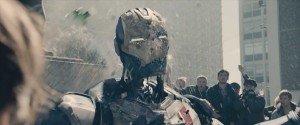
Townsend points out that ILM’s history with Hulk goes back to the Ang Lee film, but this time, “they went back to bare bones, if you’ll excuse the pun, using new muscle simulation, new shaders, new textures, a new hair pipeline. It really is a new Hulk.”
Hair, of course, is famous for clogging up pipelines in the off-screen world, but again — even if the metaphor changes from music to plumbing, Cioffi credits Townsend with keeping everything humming along. “We shared shots,” he said, of Trixter and the other vendors. “We’d do animation in the foreground; someone else would do the background.”
“Every house has its own proprietary software,” he added. “So setups can be exchanged up to a certain degree. We definitely exchange assets in terms of textures and models. We do sometimes even exchange animation curves, or fixed files.”
“This show is full of FX,” he continues, noting that Trixter alone had about 400 shots to work on.
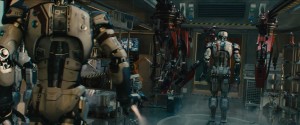 Trixter’s animation supervisor, Simone Kraus, was on set during their sequences, overseeing much of their work.
Trixter’s animation supervisor, Simone Kraus, was on set during their sequences, overseeing much of their work.
The on-set aspect included a mo-cap stage set up at Shepperton Studios where most of the filming was taking place. Being able to do greenscreen work next door to the physical sets made it “very easy for the actors and the supervisors to go there, even between shots, and we had editorial attached,” she said.
Both Ruffalo’s Hulk, and James Spader’s Ultron, made use of the facility so they could deliver performances that felt as real possible while being, essentially, onset.
That facility was built with “guidance from Andy Serkis’ company, Imaginarium,” Townsend noted. “Though we chose to build our own version of the stage – our permanent home for mo-cap.” (Serkis is in the film playing Ulysses Klaue, a character who will re-appear in Marvel’s upcoming Black Panther film).
“So when James first came to the set,” Townsend explained, “we put him in a mo-cap suit.” Spader had been insistent that if he took the Ultron role, he didn’t want to only voice act for a CG character, but like Serkis with his Planet of the Apes and Lord of the Rings work, and Ruffalo’s previous Hulk, really wanted to perform the character.
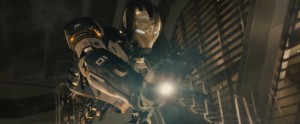 A lot of that started with physical work, making his moves more robotic. “We put weights and braces on his body to restrict his movement.”
A lot of that started with physical work, making his moves more robotic. “We put weights and braces on his body to restrict his movement.”
“We had to find a body language,” Kraus added. “At first we experimented with a few things. How can we make his movements physically believable?”
“Then James had the idea – one of his arms isn’t working properly,” as the actor worked to incorporate Ultron’s banged up metallic body into his work “so he put his arm in a sling,” Kraus recalled, and then kept performing with the additional restriction.
“Even though there is no facial performance, you can see James Spader,” Townsend said. “Then Trixter took those mo-cap performances, which we shot on set.”
Trixter worked exclusively on the “initial stage of Ultron’s physical appearance” Cioffi said – the Ultron Mark I. It is inventor Tony “Iron Man” Stark who must face his robots-gone-bad as one of the film’s key plot elements.
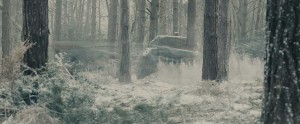 But Trixter was there for the evolution of other characters as well. “We were finishing Captain America: Winter Soldier,’ we worked on the tag – inserted in the title sequence – of the two siblings kept in observation. From Marvel’s side, that was meant to introduce these two new characters.”
But Trixter was there for the evolution of other characters as well. “We were finishing Captain America: Winter Soldier,’ we worked on the tag – inserted in the title sequence – of the two siblings kept in observation. From Marvel’s side, that was meant to introduce these two new characters.”
Those two new characters, of course, were the Scarlet Witch and Quicksilver, which “from Chris’ point of view,” said Cioffi, provided “an opportunity to start investigating the effects they would use to bring the characters to life.”
It’s an example of how far in advance Marvel works with all its puzzle pieces. Not only are their renowned teasers ways to get a head start on upcoming character work, but sequences are done in advance to start whetting appetites as well.
“We had a rather large amount of shots to do for Comic-Con,” Kraus recalled. All this while Trixter was also experimenting with “different frame rates, tracking cameras, or simple pans,” as Cioffi recounted, exploring “what the relation between foreground and background could be,” in shots involving Quicksilver’s powers of ultra-speed.
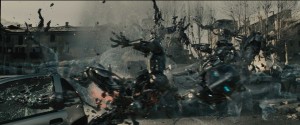 “That was a great starting point,” Townsend agreed, of the teaser footages and Comic-con sequences. “Trixter was very involved in creating the look” of the two superpowered Maximoff siblings. “We played with it in different places and different locales. Once we established that, we handed that off, along with the recipes.”
“That was a great starting point,” Townsend agreed, of the teaser footages and Comic-con sequences. “Trixter was very involved in creating the look” of the two superpowered Maximoff siblings. “We played with it in different places and different locales. Once we established that, we handed that off, along with the recipes.”
“One of my desires is always to share the information, and share the knowledge,” Townsend emphasized.
So metaphors for how all this work is coordinated, or symphonically arranged, between a global array of visual FX houses are as numerous as Avengers themselves. But whether it’s music or baking, things are left simmering until the very end. “We’re always chasing the very best movie we can, up to the very last minute,” Townsend said.
And given how they work, rehearsals for the next symphony, and ingredients for the next stew, are already being assembled.





